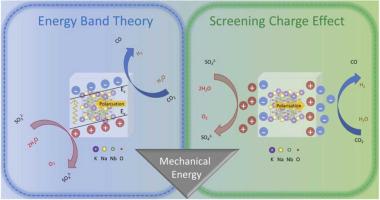Nano Energy ( IF 16.8 ) Pub Date : 2022-02-09 , DOI: 10.1016/j.nanoen.2022.107032
Pham Thi Thuy Phuong, Dai-Viet N. Vo, Nguyen Phuc Hoang Duy, Holly Pearce, Zois Michail Tsikriteas, Eleanor Roake, Chris Bowen, Hamideh Khanbareh

|
The increase in global energy demand, together with a rise in carbon dioxide (CO2) levels have encouraged research into the reduction of CO2 into useful chemicals and fuels. In this paper, we demonstrate the piezo-catalytic reduction of CO2 using lead-free lithium-doped potassium sodium niobate (KNN) ferroelectric ceramic particulates. The application of acoustic waves generated by ultrasound to a suspension of the ceramics particles creates pressure waves result in a large change in the spontaneous polarisation of the KNN particles via the piezoelectric effect, which in turn creates surfaces charges for CO2 reduction. The effect of CO2 gas concentration, the presence of dissolved species, and catalyst loading on piezo-catalytic performance are explored. By optimization of the piezo-catalytic effect, a promising piezo-catalytic CO2 reduction rate of 438 μmol g−1 h−1 is achieved, which is much larger than the those obtained from pyro-catalytic effects. This efficient and polarisation tuneable piezo-catalytic route has potential to promote the development of CO2 reduction via the utilisation of vibrational energy for environmental benefit.
中文翻译:

使用无铅铁电颗粒有效减少二氧化碳的压电催化
全球能源需求的增加,以及二氧化碳 (CO 2 ) 水平的上升,促进了将 CO 2还原为有用化学品和燃料的研究。在本文中,我们展示了使用无铅锂掺杂铌酸钾钠 (KNN) 铁电陶瓷颗粒的压电催化还原 CO 2 。将超声波产生的声波施加到陶瓷颗粒的悬浮液中会产生压力波,从而通过压电效应导致 KNN 颗粒的自发极化发生巨大变化,进而产生用于 CO 2还原的表面电荷。CO 2的影响研究了气体浓度、溶解物质的存在和催化剂负载对压电催化性能的影响。通过优化压电催化效应,实现了有希望的 438 μmol g -1 h -1的压电催化 CO 2还原率,远大于热催化效应。这种高效且极化可调的压电催化途径具有通过利用振动能促进CO 2还原的发展以造福环境。

































 京公网安备 11010802027423号
京公网安备 11010802027423号